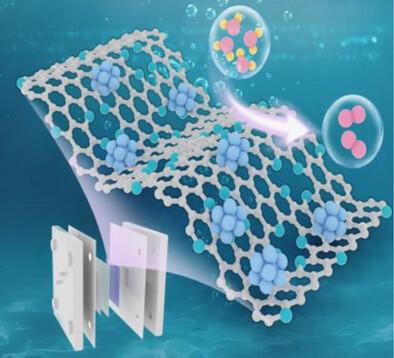Confined Atom Escape and Nucleation Delivering Iridium-Based Nanoparticles with Ultrahigh Mass Activity for Acidic Water Oxidation
IF 26
1区 材料科学
Q1 CHEMISTRY, PHYSICAL
引用次数: 0
Abstract
Achieving high catalytic activity and stability with as little iridium (Ir) as possible is essential for the widespread deployment of proton exchange membrane water electrolysis (PEMWE). Although single-atom dispersion strategies could maximize the utilization of iridium, they usually suffer from unsatisfactory stability issues. Here, a method is reported of growing highly dispersed iridium-based nanoparticles with unprecedented mass activity and stability through confined atom escape and nucleation (CAEN). Unlike conventional synthesis methods in which all metal precursors are free to nucleate, CAEN is characterized by a tunable confinement of metal single atoms in the carbon substrate by asymmetric nitrogen, oxygen-coordination, which establishes a thermodynamic and kinetic equilibrium between single-atom dispersion and nucleation, prevents the growth of metastable phases, and delivers highly stable nanoparticles with durable active surfaces. The acidic oxygen evolution reaction (OER) mass activity of the designed catalyst reaches 2040.8 A gIr−1, which is about 25 times that of commercial Ir/C (81.60 A gIr−1), and the durability is improved by an order of magnitude. This CAEN method can be further extended to the synthesis of iridium-based intermetallic nanoparticles, resulting in a more than 50-fold increase in OER mass activity, opening up a completely new path for the design of high-performance catalysts.

具有超高质量活性的铱基纳米颗粒在酸性水氧化中的约束原子逸出和成核
以尽可能少的铱(Ir)实现高催化活性和稳定性是质子交换膜水电解(PEMWE)广泛应用的必要条件。虽然单原子分散策略可以最大限度地利用铱,但它们通常存在令人不满意的稳定性问题。本文报道了一种通过限制原子逸出和成核(CAEN)来生长具有空前质量活性和稳定性的高度分散的铱基纳米颗粒的方法。与传统的所有金属前驱体都可以自由成核的合成方法不同,CAEN的特点是通过不对称氮、氧配位将金属单原子限制在碳衬底上,从而在单原子分散和成核之间建立热力学和动力学平衡,防止亚稳相的生长,并提供具有持久活性表面的高度稳定的纳米颗粒。设计的催化剂的酸性析氧反应(OER)质量活性达到2040.8 A gIr−1,是商品Ir/C (81.60 A gIr−1)的25倍左右,耐久性提高了一个数量级。这种CAEN方法可以进一步扩展到铱基金属间纳米颗粒的合成,使OER质量活性提高50倍以上,为高性能催化剂的设计开辟了全新的途径。
本文章由计算机程序翻译,如有差异,请以英文原文为准。
求助全文
约1分钟内获得全文
求助全文
来源期刊

Advanced Energy Materials
CHEMISTRY, PHYSICAL-ENERGY & FUELS
CiteScore
41.90
自引率
4.00%
发文量
889
审稿时长
1.4 months
期刊介绍:
Established in 2011, Advanced Energy Materials is an international, interdisciplinary, English-language journal that focuses on materials used in energy harvesting, conversion, and storage. It is regarded as a top-quality journal alongside Advanced Materials, Advanced Functional Materials, and Small.
With a 2022 Impact Factor of 27.8, Advanced Energy Materials is considered a prime source for the best energy-related research. The journal covers a wide range of topics in energy-related research, including organic and inorganic photovoltaics, batteries and supercapacitors, fuel cells, hydrogen generation and storage, thermoelectrics, water splitting and photocatalysis, solar fuels and thermosolar power, magnetocalorics, and piezoelectronics.
The readership of Advanced Energy Materials includes materials scientists, chemists, physicists, and engineers in both academia and industry. The journal is indexed in various databases and collections, such as Advanced Technologies & Aerospace Database, FIZ Karlsruhe, INSPEC (IET), Science Citation Index Expanded, Technology Collection, and Web of Science, among others.
 求助内容:
求助内容: 应助结果提醒方式:
应助结果提醒方式:


